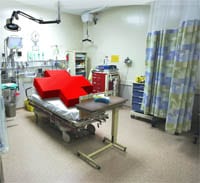A Matter of Life or Death Why Health Care Quality is More Than a Catchphrase
Numbers are abstract things, and often difficult to comprehend in real terms. Ask, for instance, anyone who’s tried to comprehend the enormity of a trillion during the recent economic-stimulus debate on Capitol Hill.
But even smaller numbers can remain amorphous unless put into human terms. Take, for example, 99,000.
That’s the upper estimate, 10 years ago, of how many lives were being lost annually to medical errors. The now-famous 1999 report by the Institute of Medicine actually put the range between 50,000 and 99,000. Dr. William Bithoney tried to put it in harsher, more understandable terms.
“It was likened to a jumbo jet crashing every other day, with all hands killed,” said Bithoney, chief medical officer of the Sisters of Providence Health System and COO of Mercy Medical Center. “This is a major problem. Ninety-nine thousand is many more than those killed in car accidents, cancer, heart disease — it’s just a horrific problem. And now, 10 years later, it has engendered a huge movement.”
Indeed, the past decade has seen a nationwide revolution in the way hospitals track their processes and prevent possibly life-threatening mistakes.
Many were no doubt spurred by the Institute of Medicine report, titled “To Err Is Human,” and its followup study a few years later, called “Crossing the Quality Chasm.” Both received widespread attention in the health care industry and the media.
“Those are the two bibles,” said Evan Benjamin, vice president of Healthcare Quality for Baystate Health. “They break down the problems with the U.S health care system and make specific recommendations of changes that need to be made.”
The later report, he explained, reduced the needs of health care to six basics: the practice of medicine has to be — roughly in order of importance — safe, effective, patient-centered, timely, efficient, and equitable. “Those six aims quickly became the core of a revolution in health care,” he said.
For its part, though, Baystate was slightly ahead of the curve, launching new safety protocols 12 years ago that formed the basis of today’s ongoing efforts.
“We began to look at the tea leaves of where health care was going, and we recognized that health care quality was going to be the core issue,” Benjamin told The Healthcare News.
In fact, according to the available tracking evidence — and there is plenty of it — Massachusetts hospitals in general are doing a better job of streamlining processes from surgery prep to heart-attack treatment to drug prescribing than the average U.S. institution, leading to better outcomes and more lives saved.
That’s a positive in more ways than one, because some administrators believe the health care system is moving toward a ‘pay-for-performance’ framework by which providers will be paid according to how well they achieve certain quality and safety goals.
This month, The Healthcare News examines some of those goals, what hospitals have done to institutionalize them, and why safety has become far more than a buzzword in health care.
Public Records
When the government gets involved, people take notice.
And one of the most visible signs of that involvement, where patient safety is concerned, is a Web site called “Hospital Compare”
(www.hospitalcompare.hhs.gov) launched by the Centers for Medicare & Medicaid Services. The site does exactly that, compare individual hospitals’ performance on certain safety measures (evaluated most recently throughout 2007) with state and national averages.
Bithoney was happy to rattle a few statistics off the Web site. For instance, in 2007, while 84{06cf2b9696b159f874511d23dbc893eb1ac83014175ed30550cfff22781411e5} of hospital patients nationally received the appropriate preventative antibiotics one hour prior to surgery, 92{06cf2b9696b159f874511d23dbc893eb1ac83014175ed30550cfff22781411e5} did at Mercy. While 80{06cf2b9696b159f874511d23dbc893eb1ac83014175ed30550cfff22781411e5} of surgery patients nationally were ordered treatments to prevent blood clots, 90{06cf2b9696b159f874511d23dbc893eb1ac83014175ed30550cfff22781411e5} did at Mercy.
There are dozens of such comparisons, from complicated evaluations to simple measures, such as the percentage of Mercy’s heart-attack patients who were given aspirin upon arrival (96{06cf2b9696b159f874511d23dbc893eb1ac83014175ed30550cfff22781411e5}) and upon discharge (100{06cf2b9696b159f874511d23dbc893eb1ac83014175ed30550cfff22781411e5}), both above the national average.
More important, however, to Bithoney is another comparison, this one conducted by Blue Cross Blue Shield that ranks hospitals by adjusted mortality rates. That word ‘adjusted’ is important, he said, since some hospitals consistently receive the most critical patients, so naturally the chance of death is greater.
This chart, however, takes into account the severity of patients’ conditions and adjusts the figures accordingly. Among all 18 community hospitals in its general size bracket across Massachusetts, Mercy recorded the lowest adjusted mortality rate in the state, both overall and specifically after major surgery.
“This risk adjustment is critical,” said Bithoney, because some hospitals transfer the most serious patients to other hospitals, which then take on the additional risk. “For example, Mass General gets all that coronary care, so its raw mortality rate doesn’t make sense.”
The adjusted rate, however, better reflects the general care patients are getting, particularly in critical and surgical cases — and that must, he said, reflect in some way on all the individual care measures, from aspirin for heart-attack victims to cutting down on infections during surgery.
“You can’t prove that any one of these things is directly related to lower mortality rates,” said Bithoney, “but if you do all of these things and adhere to the national patient-safety goals, it will make an impact.
“We have hundreds of things happening to try to improve quality at Mercy,” he continued. “We have a culture of safety here. That is our goal: to ensure that, every single day, our doctors, nurses, and everyone else do these things properly.”
A quick check of the Hospital Compare Web site reveals another positive: across the board, Massachusetts hospitals outperform the national average, sometimes significantly so, when it comes to meeting the quality measures.
“I think it is fantastic that Mass-achusetts’ hospitals are taking the lead on these patient care and quality improvement initiatives,” said Carol M. Smith, chief nursing officer and chief operating officer of Cooley Dickinson Hospital. “These initiatives have charged us with being more accountable and transparent through the public reporting of our quality data.”
Donna Truesdell, director of quality improvement at CDH, says she has seen a “fascinating synergy” going on with these patient-care and quality-improvement programs. “Cooley Dickinson has always looked for ways to improve patient care and outcomes, but I think these programs have greatly accelerated and centralized our efforts. These initiatives are leading a revolution in health care across the nation.”
Through its participation in national patient-safety campaigns, Cooley Dick-inson has achieved ‘mentor’ status in the categories of preventing ventilator-associated pneumonia, preventing central line infections, and preventing adverse drug events by reconciling medications. CDH was recognized by CareScience as one of only six hospitals to achieve both Select National Quality Leader status — a distinction given to the top 1{06cf2b9696b159f874511d23dbc893eb1ac83014175ed30550cfff22781411e5} of hospitals nationwide — and designation as a top-performing hospital in three of seven disease categories including heart failure, ischemic stroke, and pneumonia.
CDH was also featured in an October 2006 Newsweek magazine case study as one of 10 hospitals across America that are using innovation, hard work, and imagination to reduce errors and save money.
Holyoke Medical Center has made patient safety a systemic effort as well, from reducing the incidence of venous thromboembolism — dangerous blood clotting — in surgery to streamlining the administration of anticoagulant medications, which have bee associated with some high-profile, fatal errors nationally.
Another example is computerized physician order entry, a system by which doctors directly input prescriptions using a computer, rather than writing them or phoning them in using third parties.
“The emphasis is on patient safety and improving care, in addition to cost reduction,” said Tina Null, director of patient safety at HMC. “Our goals are achieved through error reduction, improved access to data, and improved efficiency. Electronic records reduce errors by eliminating things like illegible handwriting, and when you don’t have another person transcribing what’s written, the fewer steps there are in the process, which also makes errors less likely.”
Similarly, the hospital has forbidden the use of abbreviations in prescribing, another way to reduce errors by decreasing the opportunity to make a mistake.
“Massachusetts has mandated certain computerized data by 2012, but we’re ahead of the curve,” said Null. “We’ve already begun to implement this and get our physicians on board with this process.”
Bottom-line Concerns
Some of these steps are driven by outside regulatory influence and required by agencies such as the Joint Commission on the Accreditation of Healthcare Organiz-ations, Null said. “But they’re also areas where we’ve found potential problems and opportunities to improve. We have in place a multifaceted process to identify weaknesses in the system, and we’ve been proactive in identifying those and developing teams to fix them.”
Such measures are based on solid evidence, said Benjamin — for instance, the fact that lives are saved when heart-attack patients are brought to a cardiac catheterization lab to open the blood vessels within 90 minutes of the episode.
“Our rate is nearly 100{06cf2b9696b159f874511d23dbc893eb1ac83014175ed30550cfff22781411e5} in doing that,” he noted. “It takes a lot of work to coordinate that and make it happen. That’s how we want to do things: apply evidence wherever we can and then look at the big picture.
“It needs to start at the top,” Benjamin continued. “You need to have the board involved, understanding what quality is and helping to define annual and five-year goals as part of a core strategic plan. Quality is the number-one goal priority that has to be driven down into the management committees and reviewed on an ongoing basis.”
Baystate’s efforts have led to its recognition as a mentor hospital for goals such as how to improve surgical care and reduce complications. “This is a passion for us,” he said.
Passion aside, one reason hospitals are giving careful attention to improving quality measures and patient safety is a trend toward pay for performance (P4P), which ties financial reimbursement to such outcomes. Private and public payers, including Medicare and some Medicaid networks, have experimented with P4P, but some hospital administrators predict an upswing in the trend, particularly if health care is eventually nationalized.
But, according to a report by Mathematica Inc., a health care policy research organization, there are a number of potential limitations or problems associated with P4P programs.
First is a potentially narrow clinical focus. “Most P4P programs include a narrow set of quality measures aimed at limited numbers of services and patient groups,” the report reads. “There are also concerns that providers will devote more attention to patients with conditions pertaining to quality measures than to other patients (i.e., ‘manage to the metric’), thus resulting in declines in quality of care not measured.”
Concerns have also arisen about whether providers or patients are most responsible for particular outcomes, and how to determine which outcomes should be attributed to which providers in making P4P payments. “In addition, outcomes-based P4P programs may lead to concerns about financial penalties for providers who tend to treat sicker patients, or, conversely, the introduction of incentives for providers to ‘cherry-pick’ the healthiest patients.”
This issue may be addressed by risk-adjustment methods such as the one Blue Cross Blue Shield employed; however, most risk-adjustment methods are in their early stages of development, the report notes.
Finally, because outcome measures often focus on selected clinical conditions, Mathematica notes, the data for a particular provider may be based on a relatively small number of patients, leading to potentially imprecise or unstable estimates.
To hear area hospital administrators tell it, however, the reimbursement factor is — and should be — only one part of the rationale for achieving quality-outcome goals. For Bithoney, there’s really one measure that matters most, and that’s whether a patient lives or dies.
“I know other hospitals are doing some of these things we’re doing, but there’s no other large community hospital that beats us,” he said. “We’re very proud of these things. It’s all about the outcomes.”


